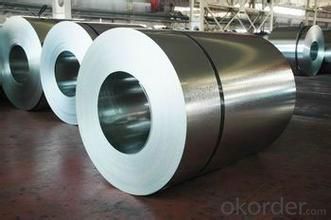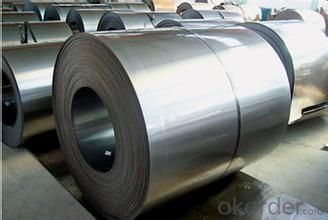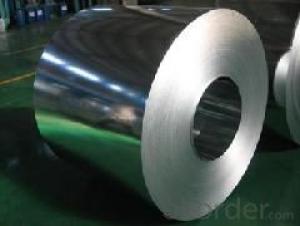Hot-Dip Galvanized Steel Coil with Competitive Price
- Loading Port:
- Shanghai
- Payment Terms:
- TT OR LC
- Min Order Qty:
- 50 m.t.
- Supply Capability:
- 10000 m.t./month
OKorder Service Pledge
OKorder Financial Service
You Might Also Like
1. Hot-Dip Galvanized Steel Coil Description:
Hot-dip galvanized steel coil are available with a pure zinc coating through the hot-dip galvanizing process. It offers the economy, strength and formability of steel combined with the corrosion resistance of zinc. The hot-dip process is the process by which steel gets coated in layers of zinc to protect against rust. It is especially useful for countless outdoor and industrial application.
2.Main Features of the Hot-Dip Galvanized Steel Coil:
• Excellent process capability
• Smooth and flat surface
• Workability, durability
• Excellent heat resistance performance
• High strength
• Good formability
• Good visual effect
3.Hot-Dip Galvanized Steel Coil Images


4.Hot-Dip Galvanized Steel Coil Specification
Standard: AISI, ASTM, BS, DIN, GB, JIS
Grade: SPCC, SPCD, Q195, DX51D
Thickness: 0.15-5.0mm
Model Number: coil
Type: Steel Coil
Technique: Cold Rolled
Surface Treatment: Galvanized
Application: Container Plate
Special Use: High-strength Steel Plate
Width: 600-1250mm
Length: depends
commodity: hot dipped galvanized steel coil
technique: cold rolled
thickness: 0.15-5.0mm
width: 600-1500mm
surface treatment: galvanized
zinc coating: 50-275g/m2
coil weight: 3-7 tons
coil ID: 508/610mm
spangle: zero spangle, regular spangle, small spangle, big spangle
payment term: by L/C or T/T
5.FAQ of Hot-Dip Galvanized Steel Coil
What’s the application of this product?
There are many applications for this product. For example, roofing, cladding, decking, tiles, sandwich walls, etc.
What’s the coating composition of Hot-Dip Galvanized Steel Coil?
The coating composition is 55% aluminium in weight ratio, 43.4% zinc, and 1.5% silicon, with excellent corrosion and heat resistance performance.
- Q:How are steel coils used in the production of electrical transmission towers?
- Steel coils are used in the production of electrical transmission towers as they are shaped and welded to create the structural framework of the towers. The coils are unrolled, cut, and formed into the required shape, providing strength and stability to support power lines and equipment.
- Q:What are the common defects in steel coils?
- Some common defects in steel coils include surface defects like scratches, rust, and pits, as well as internal defects like cracks, laminations, and non-uniform thickness. Other defects may include coil set, which is a curvature in the coil, and edge wave, which is a distortion along the edges of the coil.
- Q:I have a steel plate 3' long x 2 wide x 3/16 thick. I have a 1/2 diameter hole with the center 3/4 from the end. Tensile strength is 38,000psi. A chain goes through the hole and is connected to a load. how does one determine how much tension the chain can have before it rips through the hole?
- oo that's a tough one. dont remember... just finished that class...sorry
- Q:i know stainless steel swords are decoration, what metal is ok for a sword that is usable
- Why the interest in a 'usable' sword ~~ are you really going to use it?
- Q:How can defects in steel coils be detected?
- Defects in steel coils can be detected through various methods such as visual inspection, non-destructive testing techniques like ultrasonic testing, magnetic particle inspection, eddy current testing, and radiographic testing. These methods help identify surface defects, internal discontinuities, cracks, or other irregularities in the steel coils.
- Q:How do steel coils contribute to the packaging industry?
- Steel coils play a crucial role in the packaging industry by providing a durable and versatile material for packaging various products. The use of steel coils in packaging ensures the protection and preservation of goods during transportation and storage. One way steel coils contribute to the packaging industry is through their strength and durability. Steel is known for its high strength-to-weight ratio, making it an ideal material for packaging heavy and bulky items. Steel coils can withstand significant pressure and impact, ensuring that goods remain intact and undamaged throughout the supply chain. This strength also allows for the stacking of packages, optimizing storage space and reducing the risk of damage. Furthermore, steel coils are highly resistant to corrosion and moisture. This property is particularly important in the packaging industry as it helps protect goods from environmental factors that could potentially compromise their quality. Steel coils can be coated or treated to enhance their corrosion resistance, ensuring that packaged products remain in pristine condition. Steel coils are also versatile and can be easily customized to suit specific packaging requirements. They can be cut and shaped into various forms, such as sheets, straps, or bands, to secure and protect different types of products. Additionally, steel coils can be easily integrated with other packaging materials, such as cardboard or plastic, to provide added strength and stability. Another benefit of steel coils in the packaging industry is their recyclability. Steel is one of the most recycled materials globally, and steel coils can be easily recycled and reused. This sustainability aspect makes steel coils an environmentally friendly choice for packaging, contributing to the reduction of waste and the conservation of resources. In summary, steel coils play a vital role in the packaging industry by offering strength, durability, corrosion resistance, versatility, and recyclability. Their use ensures the safe transport and storage of goods, providing a reliable and sustainable packaging solution for a wide range of industries.
- Q:I've heard different things bout them, though I do not know this. Oh, and if you know where you can buy some raw or get custom made stuff out of black steel please let me know it would be greatly appreciated. Oh and my friend told me there is a black steel that can be sharpened and silver will be underneath, is this also true? Thank you very much for answering ^^
- My son is a bit and spur maker,I asked him about that and he told me that it is a tag they put on bits so a novice person will pay more for a bit that is not any better. Steel is Steel You should have a lot of bite with that bit because it is a pretty fine diameter. The black patina will wear off with use. BTW he just sent two silver bits to a big show in Reno Nev. I have not seen them or pictures of them but he has a $2,000 price tag on each of them. They must be real elaborate probably very fancy spade bits with highly engraved multicolored different metal butterflies on the ports.
- Q:How are steel coils used in the manufacturing of body panels?
- Steel coils are used in the manufacturing of body panels by being processed and shaped into flat sheets or strips. These sheets or strips are then further formed, cut, and welded to create various body panels, such as doors, hoods, and fenders, which are essential components of vehicles.
- Q:Can steel coils be used in outdoor applications?
- Yes, steel coils can be used in outdoor applications. Steel is known for its durability and resistance to harsh environmental conditions, making it suitable for outdoor use. Additionally, steel coils are often coated or treated to further enhance their corrosion resistance, making them well-suited for various outdoor applications such as construction, automotive, and manufacturing industries.
- Q:What are the different methods of perforating steel coils?
- There are several methods used for perforating steel coils, each with its own advantages and applications. 1. Mechanical Punching: This is one of the most common methods used for perforating steel coils. It involves using a mechanical press to punch holes in the coil using a punch and die set. The size and shape of the holes can be customized based on the design of the punch and die set. Mechanical punching is efficient and can produce high-quality holes with consistent results. 2. Laser Cutting: Laser cutting is a popular method used for perforating steel coils, especially when complex hole patterns or intricate designs are required. It involves using a high-powered laser beam to cut through the steel coil, creating precise and clean holes. Laser cutting offers flexibility in terms of hole size, shape, and spacing, and it can be computer-controlled for precise and repeatable results. 3. CNC Plasma Cutting: This method involves using a high-velocity plasma jet to cut through the steel coil and create perforations. CNC (Computer Numerical Control) technology is used to guide the plasma cutter, enabling precise and accurate hole patterns. CNC plasma cutting is ideal for thicker steel coils and can produce larger holes compared to laser cutting. 4. Waterjet Cutting: Waterjet cutting uses a high-pressure jet of water mixed with an abrasive material to cut through the steel coil. This method offers versatility in terms of hole size, shape, and material compatibility. Waterjet cutting is known for its ability to produce intricate and precise perforations without heat-affected zones or distortion. 5. Electrical Discharge Machining (EDM): EDM is a method that utilizes electrical discharges to erode the material and create perforations in the steel coil. It involves using a conductive electrode and a dielectric fluid to generate controlled sparks that remove material and form holes. EDM can be used to create complex shapes and patterns and is particularly suitable for hard materials. The choice of method depends on factors such as the desired hole size and shape, the thickness and type of the steel coil, the required precision, and the production volume. Each method has its own advantages and limitations, and it is important to select the most appropriate method based on the specific requirements of the perforated steel coils.
1. Manufacturer Overview |
|
|---|---|
| Location | |
| Year Established | |
| Annual Output Value | |
| Main Markets | |
| Company Certifications | |
2. Manufacturer Certificates |
|
|---|---|
| a) Certification Name | |
| Range | |
| Reference | |
| Validity Period | |
3. Manufacturer Capability |
|
|---|---|
| a)Trade Capacity | |
| Nearest Port | |
| Export Percentage | |
| No.of Employees in Trade Department | |
| Language Spoken: | |
| b)Factory Information | |
| Factory Size: | |
| No. of Production Lines | |
| Contract Manufacturing | |
| Product Price Range | |
Send your message to us
Hot-Dip Galvanized Steel Coil with Competitive Price
- Loading Port:
- Shanghai
- Payment Terms:
- TT OR LC
- Min Order Qty:
- 50 m.t.
- Supply Capability:
- 10000 m.t./month
OKorder Service Pledge
OKorder Financial Service
Similar products
New products
Hot products
Related keywords




























